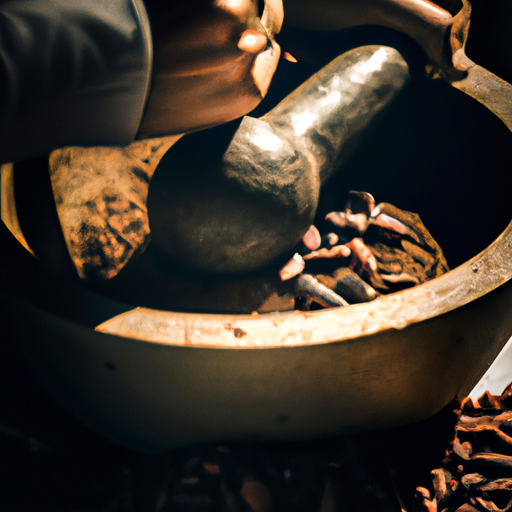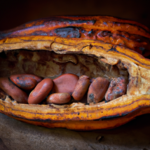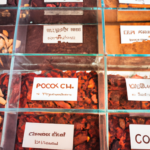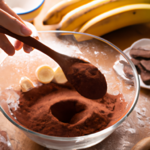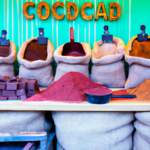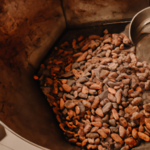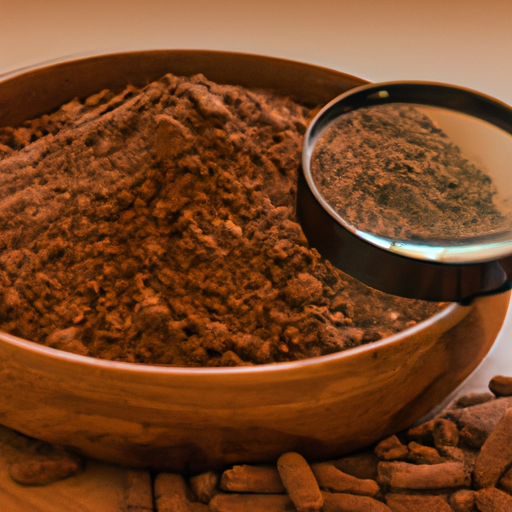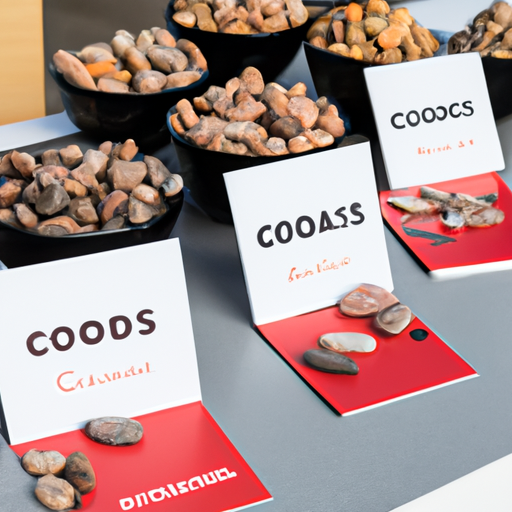I enter the kitchen and I am greeted by a delightful, chocolatey smell. My attention is immediately captured by a humble little jar on the counter. Within it rests a deep brown powder, the essence of raw cacao just waiting to be released. This is the beginning of something magical.
Welcome to the world of raw cacao powder, a hidden treasure that holds a plethora of health benefits and culinary delights. Derived from the seeds of the cacao tree, this unprocessed form of chocolate is a powerhouse of nutrients and antioxidants. In addition to being a rich source of magnesium, iron, and fiber, raw cacao powder is also known to lift moods and boost energy levels. Many individuals enjoy incorporating raw cacao powder into their daily routine, whether it’s in smoothies, oatmeal, or even their morning brew with mushrooms for a delicious and nutritious start to the day. With its versatility and health benefits, it’s no wonder why raw cacao powder has become a staple in the kitchens of health-conscious individuals around the world.
In this article, we will delve into the origins, nutritional profile, and health benefits of raw cacao powder. We will explore its versatile uses in the kitchen and understand the difference between this raw form and processed cocoa powder.
Furthermore, we will discuss how to choose and store raw cacao powder responsibly, considering sustainability and ethical considerations.
So, join me on this journey as we unravel the mysteries of raw cacao powder and discover how it can be embraced in our everyday lives.
Key Takeaways
- Raw cacao powder is derived from the seeds of the cacao tree and is unprocessed chocolate, rich in nutrients and antioxidants.
- It has historical and cultural significance, as it was used by Mayans and Aztecs in religious ceremonies and as a form of currency.
- Raw cacao powder is high in magnesium, iron, and flavonoids, which improve heart health and fight free radicals and inflammation.
- It can be used in various recipes, adding depth and richness to dishes and desserts, and is a healthier alternative to processed cocoa powder.
Origins of Raw Cacao Powder
Let’s dig into the fascinating origins of raw cacao powder!
Raw cacao powder has a rich cultural significance and historical uses that date back thousands of years.
The ancient Mayans and Aztecs revered cacao as a sacred plant, using it in religious ceremonies and as a currency. They believed it had mystical properties and associated it with fertility and abundance.
Cacao beans were even used as a form of currency in their societies.
The historical uses of cacao also include medicinal purposes, as it was believed to have healing properties.
Today, we can appreciate the cultural and historical significance of raw cacao powder as we explore its nutritional profile.
It’s time to discover the incredible benefits this ancient superfood has to offer!
Nutritional Profile of Raw Cacao Powder
The nutritional profile of raw cacao powder is packed with vitamins, minerals, and antioxidants, making it a healthy addition to your diet.
This dark chocolate ingredient contains high levels of magnesium, which is important for maintaining healthy bones and reducing the risk of heart disease. It also provides a significant amount of iron, essential for transporting oxygen throughout the body and preventing anemia.
Raw cacao powder is rich in flavonoids, a type of antioxidant that can help protect against oxidative stress and inflammation. These antioxidants have been linked to various health benefits, including improved heart health and reduced risk of chronic diseases.
Additionally, raw cacao powder is versatile and can be used in a variety of recipes, from smoothies and desserts to savory dishes.
Transitioning to the next section, the health benefits of raw cacao powder extend beyond its nutritional benefits.
Health Benefits of Raw Cacao Powder
Indulging in the rich, velvety goodness of raw cacao can transport your taste buds to a world of decadence and delight, while nourishing your body with a plethora of health benefits.
Raw cacao powder is packed with antioxidants, which help fight off free radicals and reduce inflammation in the body. It also contains high levels of magnesium, a mineral essential for healthy nerve function and strong bones.
Additionally, raw cacao powder is a great source of iron, which is important for oxygen transport in the body. Its flavonoids have been linked to improved heart health and reduced risk of chronic diseases.
Incorporating raw cacao powder into your diet can be as simple as adding it to smoothies, oatmeal, or energy balls. It’s time to explore the culinary uses of raw cacao powder and elevate your recipes to new heights of deliciousness.
Culinary Uses of Raw Cacao Powder
Incorporating this versatile ingredient into a variety of culinary creations can result in a symphony of flavors and textures that will leave your taste buds yearning for more. Raw cacao powder is not only healthy, but it also adds depth and richness to dishes. Here are some culinary pairings and raw cacao recipes to inspire your next culinary adventure:
-
Smoothies: Add a tablespoon of raw cacao powder to your morning smoothie for a rich chocolatey flavor.
-
Baked Goods: Enhance your brownies, cookies, and cakes by substituting regular cocoa powder with raw cacao powder.
-
Hot Drinks: Create a decadent hot chocolate by whisking raw cacao powder with hot milk and sweetening it to taste.
-
Desserts: Sprinkle raw cacao powder on top of your favorite desserts like ice cream or yogurt for an added burst of flavor.
These culinary uses of raw cacao powder showcase its versatility and ability to elevate any dish.
Now, let’s explore the difference between raw cacao powder and processed cocoa powder.
Difference Between Raw Cacao Powder and Processed Cocoa Powder
Get ready to taste the sweet distinction between nature’s chocolate and its processed counterpart. When it comes to raw cacao powder versus cocoa powder, there are some key differences to consider.
Raw cacao powder is made by cold-pressing unroasted cocoa beans, which helps to retain its natural enzymes and antioxidants. On the other hand, cocoa powder is made by roasting cocoa beans at high temperatures, which can diminish some of its nutritional value.
Raw cacao powder is also higher in antioxidants, fiber, and essential minerals like magnesium and iron. These nutrients have been linked to various health benefits, including improved heart health and mood enhancement.
So, when choosing between raw cacao powder and cocoa powder, opt for the raw version to maximize its health benefits.
Now, let’s move on to learning about buying and storing raw cacao powder.
Buying and Storing Raw Cacao Powder
When buying raw cacao powder, consider these tips:
- Purchase from a reputable source for quality and purity.
- Look for organic and fair-trade certifications.
- Choose airtight packaging to maintain freshness and prevent oxidation.
- Store in a cool, dry place away from sunlight.
It’s also important to be aware of health risks:
- Raw cacao powder has high caffeine content.
- Some compounds may trigger allergies or gastrointestinal issues.
Transitioning into the next section, sustainability and ethical considerations are equally important in raw cacao production.
Sustainability and Ethical Considerations
When discussing sustainability and ethical considerations in the cacao industry, two key points that come to mind are fair trade practices and the environmental impact of cacao farming.
Fair trade practices ensure that cacao farmers receive fair wages and are not exploited in the production process.
Additionally, the environmental impact of cacao farming is a pressing concern. Deforestation and the use of pesticides can have detrimental effects on ecosystems.
It is crucial to address these issues in order to promote a more sustainable and ethical cacao industry.
Fair Trade Practices in Cacao Industry
Fair trade practices in the cacao industry ensure that farmers receive fair wages and working conditions, allowing consumers to savor the rich and guilt-free taste of raw cacao powder. Fair trade certification guarantees that cacao farmers are paid a fair price for their crops, which helps to alleviate poverty and improve their overall livelihoods.
This certification also prohibits the use of child labor in cocoa farms, protecting the rights and well-being of children. By supporting fair trade practices, consumers can contribute to the eradication of exploitative labor practices and promote sustainable and ethical cacao production.
Moving forward, it is important to consider the environmental impact of cacao farming, as this industry can have significant effects on deforestation, biodiversity loss, and climate change.
Environmental Impact of Cacao Farming
To truly understand the environmental impact of cacao farming, you must consider the devastating consequences it can have on deforestation, biodiversity loss, and climate change. For example, imagine if cacao farming continues to expand in regions with high levels of biodiversity, such as the Amazon rainforest. The result would be the destruction of countless plant and animal species, forever altering the delicate balance of this unique ecosystem.
| Environmental Impact | Concerns |
|---|---|
| Deforestation | Cacao farming often requires clearing large areas of land, leading to deforestation and the loss of valuable carbon sinks. |
| Biodiversity Loss | The destruction of natural habitats for cacao farming threatens the existence of numerous plant and animal species, jeopardizing the overall biodiversity of the affected areas. |
| Climate Change | Deforestation and the release of carbon dioxide from cleared lands contribute to climate change, exacerbating the global environmental crisis. |
These environmental sustainability concerns highlight the urgent need for responsible farming practices and the adoption of sustainable methods to mitigate the negative impacts of cacao farming. It is crucial to prioritize the protection of ecosystems and the preservation of biodiversity.
Transitioning to the subsequent section about common misconceptions about raw cacao powder, it is important to address these misconceptions with accurate information.
Common Misconceptions About Raw Cacao Powder
When it comes to raw cacao powder, there are several common misconceptions that need to be addressed.
One of these misconceptions is its caffeine content. While cacao does contain a small amount of caffeine, it is much lower than what is found in coffee or black tea.
Another misconception is that raw cacao powder is safe for everyone, but in reality, some individuals may have allergies or sensitivities to it, which can cause adverse reactions.
It is important to be aware of these misconceptions in order to make informed decisions about consuming raw cacao powder.
Caffeine Content
Amidst the rich aroma of raw cacao powder, the caffeine content pulses through like a burst of energy. Contrary to popular belief, raw cacao powder contains only a minimal amount of caffeine. On average, it contains about 12 milligrams of caffeine per ounce, which is significantly lower than the caffeine content found in coffee or black tea.
However, the presence of caffeine in raw cacao powder can still provide a mild stimulant effect, promoting alertness and enhancing mood. Additionally, raw cacao powder offers numerous health benefits, such as being rich in antioxidants, promoting cardiovascular health, and improving cognitive function.
As we delve into the next section about allergies and sensitivities, it is important to note that raw cacao powder can also trigger adverse reactions in some individuals.
Allergies and Sensitivities
Despite its numerous health benefits, individuals may experience adverse reactions to the caffeine content in cacao.
Allergies and sensitivities to cacao can manifest in various ways, such as skin rashes, hives, or digestive issues.
While true allergies to cacao are rare, some people may be sensitive to certain compounds found in cacao, such as theobromine or histamines.
It is important for individuals with known allergies or sensitivities to cacao to avoid consuming it or consult with a healthcare professional before doing so.
However, for those without allergies or sensitivities, incorporating raw cacao powder into their diet can provide culinary benefits, such as adding a rich chocolate flavor to smoothies, baked goods, or desserts.
Embracing raw cacao powder in your lifestyle can be a delicious and nutritious addition to your diet.
Conclusion: Embracing Raw Cacao Powder in Your Lifestyle
Embracing raw cacao powder in your lifestyle can be a delicious and nutritious choice. It not only provides a rich and intense chocolate flavor but also offers numerous health benefits. Research has shown that raw cacao powder can positively impact emotional well-being by boosting serotonin levels in the brain, improving mood, and reducing stress. Additionally, incorporating raw cacao powder into desserts can satisfy your sweet tooth while maintaining a nutritious diet. You can add it to smoothies, oatmeal, or use it as a substitute for traditional cocoa powder in baking recipes. With its antioxidant properties and potential mood-boosting effects, raw cacao powder is definitely worth considering as a daily addition to your routine.
Frequently Asked Questions
What is the difference between raw cacao powder and regular cocoa powder?
Raw cacao powder differs from regular cocoa powder in its processing method. Raw cacao is minimally processed, preserving more beneficial nutrients and antioxidants. It offers health benefits like improved heart health, enhanced cognitive function, and mood regulation compared to Dutch processed cocoa powder.
Can raw cacao powder be used as a substitute for regular cocoa powder in recipes?
Yes, raw cacao powder can generally be used as a substitute for regular cocoa powder in recipes. However, it’s important to note that raw cacao powder has a stronger and more intense flavor, so adjustments may be needed.
Are there any potential side effects or risks associated with consuming raw cacao powder?
There are potential side effects and risks associated with consuming raw cacao powder, such as caffeine sensitivity, allergic reactions, and digestive issues. It is important to consume it in moderation and not exceed the recommended daily intake.
How does the taste of raw cacao powder compare to regular cocoa powder?
The taste of raw cacao powder is often described as more intense, bitter, and earthy compared to regular cocoa powder. In terms of health benefits, raw cacao powder contains higher levels of antioxidants, magnesium, and other nutrients.
What are some creative ways to incorporate raw cacao powder into everyday meals and snacks?
Incorporating raw cacao powder into everyday meals and snacks is a delicious adventure. It adds a twist of unique flavor combinations, making ordinary dishes extraordinary. Plus, it offers healthy dessert alternatives that will satisfy your sweet tooth guilt-free.
Is Raw Cacao Powder Better Than Regular Cocoa Powder?
When comparing the benefits of raw cacao powder to regular cocoa powder, the raw option comes out on top. Raw cacao powder is minimally processed, retaining more nutrients and antioxidants. It offers more health benefits, such as improved heart health, better digestion, and enhanced mood.
Conclusion
Raw cacao powder is a superfood with ancient origins. Its nutritional profile is impressive, with rich antioxidants and minerals. This natural wonder offers numerous health benefits, from improving mood and cognitive function to boosting heart health. It can be used in various ways, such as sprinkling it on smoothies or incorporating it into dessert recipes. It’s important to differentiate raw cacao powder from processed cocoa powder, as the latter may lose some nutrients during additional processing. When buying raw cacao powder, choose a reputable source and store it properly to maintain freshness. Opting for fair-trade and organic options supports farmers and protects the environment. Contrary to a common misconception, raw cacao powder does not cause acne. Consuming it in moderation is always important, but there is no scientific evidence linking it to acne breakouts. Embrace this guilt-free pleasure and let raw cacao powder revolutionize your lifestyle today!


